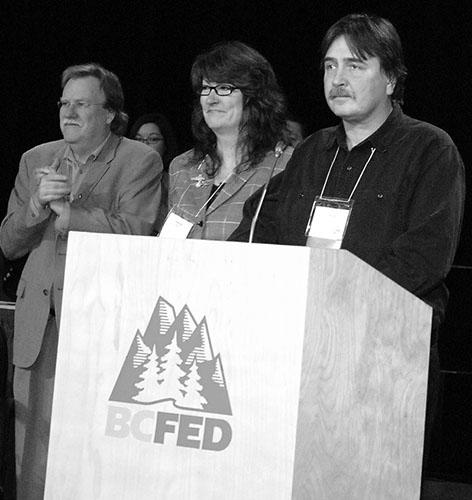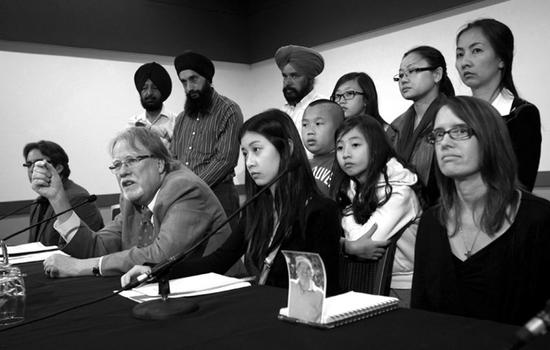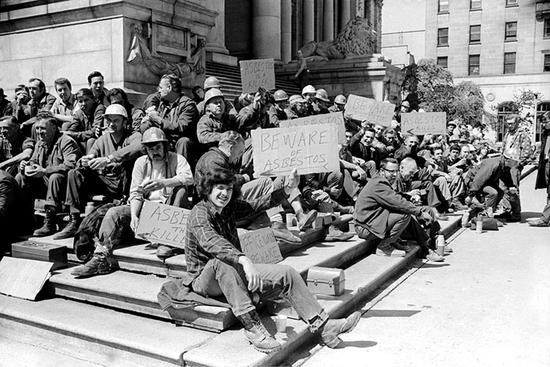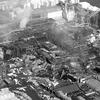23. The Golden Tree and Fighting for Workplace Safety
Beyond making organizing more difficult and gutting apprenticeship programs, the Campbell government did little to hammer unions in the private sector as they had those in the public sector. Even the NDP’s controversial anti-scab law remained in place. In part, this may have been because the private-sector unions were no longer the force they were, struggling with the impact of free trade, low-wage competition from other countries, a downturn in the resource economy and ramped-up technology on the production floor wiping out large numbers of good-paying jobs. Part-time employment claimed an increasing share of the workforce, while the real incomes of British Columbians lagged.
As the new century proceeded, the percentage of BC workers in a union, once the highest in Canada, fell to sixth-lowest, trailing even rural Prince Edward Island. It was difficult for private-sector unions to make meaningful gains at the bargaining table. Mostly they fought to hold their own, fending off employer attacks on benefits and pension plans while avoiding hard-to-win strikes. Between 2007 and 2012, an average of just fifteen hundred workers a year took up picket signs.
Yet private-sector unions did not disappear into the woodwork. Many began to focus on issues besides strikes and take-home pay. The United Steelworkers were among them. Under the leadership of its veteran director Stephen Hunt, the Steelworkers pushed the fight, with other unions and the Federation of Labour, for both a safe workplace and curbs on the influx of temporary foreign workers, often exploited by employers and seen by some as taking the jobs of British Columbians.
Hunt was passionate about worker safety. He had been part of his union’s sustained campaign to amend the Criminal Code of Canada to make employers more liable for workplace fatalities. The drive was spurred by the 1992 tragedy at the Westray coal mine in Nova Scotia when a lethal accumulation of methane gas exploded into a giant fireball, killing all twenty-six underground miners on the night shift. Although a commission of inquiry judge found that the disaster was the result of “incompetence, mismanagement, bureaucratic bungling, deceit, ruthlessness, coverups, apathy, expediency and cynical indifference” by the company and provincial safety officials, no mine manager, no CEO, no environment regulator was held responsible.
Eventually passed on March 31, 2004, after prolonged union pressure, additions to the Criminal Code known as the “Westray law” imposed new legal responsibility on employers to ensure workplace health and safety. They were now criminally liable for violations resulting in injuries or death. Since then, however, except in a few scattered cases, authorities have almost wilfully declined to use the law. Their reluctance belies the fact that more than nine hundred Canadian workers continue to die on the job every year.
In BC, when the Crown refused to charge Weyerhaeuser over the death of Lyle Hewer at its New Westminster sawmill in November 2004, Hunt launched the Steelworkers’ own prosecution. Hewer perished after a supervisor, ignoring “confined space regulations,” ordered him inside an enclosed hopper to clean out clogged wood waste, despite worker complaints that it was hazardous. The waste collapsed and Hewer was asphyxiated. Finding the company negligent, WorkSafeBC hit Weyerhaeuser with what was then a record fine of $297,000. After their own investigation, police recommended charges of criminal negligence against the company under the Westray bill. The Crown refused. (The Workers’ Compensation Board changed its name to WorkSafeBC in 2005, a branding exercise criticized by the labour movement for removing “workers” from the title and seeming to downgrade employers’ responsibility to ensure “safe work.”)
Enraged, the union hired top criminal lawyer Glen Orris to prosecute Weyer-haeuser on behalf of the union. After a three-day hearing, provincial court judge Therese Alexander cleared the way for the case to go forward. But it was not to be. The criminal justice branch awoke from its slumber to reassert control of the prosecution. Months later, the Crown decided for a second time not to proceed. Hunt assailed the decision. “A man died here in one of the most egregious cases of workplace negligence,” he said angrily. “To say we are disappointed would be an understatement.” The union’s mettle would soon be tested even more severely in a deadlier workplace tragedy.
Up north, oblivious to the global warming that had allowed the voracious pine beetle to claim vast stretches of BC forests, the winter of 2012 was still cold enough to freeze the bells off a hippie. At the Babine Forest Products sawmill in Burns Lake, fans that sucked dust outside were turned off and windows shut tight to keep workers warm as they worked long shifts to cope with the stepped-up harvesting of dead pine trees. The reduction in ventilation, plus less time for clean-up duties, led to abnormally large accumulations of fine, dry dust from the cut pine wood. But the consensus of WorkSafeBC and the forest industry was that dust levels mattered only if they affected workers’ breathing.
On the night of January 20, 2012, a huge explosion rocked the sawmill, sending enormous balls of fire racing through the plant. Workers staggered out into the cold. Twenty were burned or otherwise injured. Lead hand Robert Luggi and cut-off saw operator Carl Charlie didn’t make it. The blast seemed unfathomable. There had never been an explosion like that in the history of the BC forest industry.
Two days later, however, welder Bruce Disher singled out dust as a problem at the mill. Careful to note that he had no idea whether that caused the explosion, Disher said the dryness of the pine-beetle wood had produced “a fair amount of dust in the air. It’s 90 percent of what we’ve been cutting for the last three to four years, and it’s really dry. The dust factor [was] phenomenal.” Despite such speculation and an earlier WorkSafeBC inspection also reporting unsafe dust levels at the mill, no action was taken to check accumulation at other sawmills. Surely it was just one of those things.
It wasn’t. Three months to the day that Babine Forest Products was flattened, the Lakeland Mills sawmill on the outskirts of Prince George exploded and burned. As at Burns Lake, two workers died in the inferno: Glenn Roche and supervisor Alan Little. Co-worker Don Zwozdesky told a coroner’s inquest of seeing Roche emerge from the burning mill, his clothes seared off. “He said, ‘I’m still on fire, man … I can feel it.’” Increasingly worried about dust levels at the mill after the Babine fatalities, Roche had foreseen it happening again. Zwozdesky recalled him saying, “You watch, this place is going to bloody blow up.” Management ignored his concerns. Roche’s wife testified that he told her of extinguishing a fireball that had erupted right in front of him at work just before the explosion.
The day after Lakeland Mills went up, labour minister Margaret MacDiarmid belatedly ordered all BC sawmills to conduct “top-to-bottom” reviews of sawdust buildup. An exhaustive investigation by WorkSafeBC into the Babine explosion concluded that it had indeed been triggered by the ignition of accumulated sawdust in the mill’s basement, sparking a chain of dust-fed fireballs that roared through the premises. The agency recommended four charges against the mill owners, including a failure to prevent hazardous levels of dust. To the dismay of the victims’ families and the Steelworkers union, which represented workers at both mills, the Crown declined. Prosecutors concluded that WorkSafeBC itself had fatally damaged the case by botching its investigative procedures.
The same thing happened to the agency’s recommendation of charges against the owners of Lakeland Mills. Disheartened, exasperated and angry, the Steelworkers and the victims’ families pressed the government for an independent public inquiry into the explosions. That, too, was rebuffed. “We can’t go back. We need to go forward,” said labour minister Shirley Bond. WorkSafeBC did levy fines of $1 million and $725,000 against Babine and Lakeland Mills for violating the Workers’ Compensation Act, but both companies appealed the penalties. Lucy Campbell, sister of victim Carl Charlie, said Babine owners should pay and apologize rather than whining about the fine. “They had control over this mill. It’s a little wee penalty. No amount of money will ever replace my brother.”
Stephen Hunt reached an emotional tipping point during the coroner’s inquest into the explosions. Midway through, the Steelworkers walked out. They had lost confidence that WorkSafeBC would be held accountable for its failure to look after the safety of the mill workers, said Hunt. The Steelworkers continued to press for an independent inquiry into what had gone wrong, where witnesses would be compelled to testify under oath. The government continued to say no.
As at Westray, aggrieved families were left to mourn loved ones lost through company neglect, with no one paying a price. At an emotional ceremony by the banks of the Fraser River on the 2014 National Day of Mourning for workers killed on the job, surviving sisters and widows of the victims renewed their plea for a public inquiry and prosecutions under the Westray amendments. Robert Luggi’s widow, Maureen, recalled her husband’s last activity at home, making dinner for their son. “Then he went to work and was killed,” she said. She lamented that no one was held accountable for his “brutal death … in an unsafe workplace.” For the United Steelworkers and other unions who have taken up the cause, emotional moments like these fuel their unstinting drive for workplace accountability. Their slogan is blunt: “Kill a Worker, Go to Jail.”
The BC Federation of Labour has also been heavily involved in the campaign for workplace safety and holding negligent employers to account. At the Federation’s 2016 convention, president Irene Lanzinger choked back tears recounting the death of Kelsey Ann Kristian. Only twenty-two years old with little training, on her second day of work at a quarry near Mission she was assigned to operate a thirty-one-thousand-kilogram Caterpillar truck with no supervision. Improperly parked, the heavy vehicle rolled downhill and flipped, crushing its young driver. Eight long years after the 2007 fatality, charges of criminal negligence causing death were laid against Stave Lake Quarries and two company personnel. It was the first time such a charge had been laid in BC over an industrial fatality. But the judge imposed a fine of $100,000 rather than jail. “That employer deserved a prison sentence,” an emotional Lanzinger said.
The torch had been passed to Lanzinger by her predecessor Jim Sinclair. He had pursued workplace safety with a passion throughout his unprecedented fifteen years in the Federation’s top job. He first embraced the cause in 1982 when he was sent by the fishermen’s union newspaper, The Fisherman, to report on a ghastly fish-plant injury. Twenty-year-old Scott Patterson lost both legs when he slipped into the path of the grinding blades of an ice auger. Sinclair discovered that a protective safety grate had been removed to allow the auger to operate more efficiently. He took on the issue and within eighteen months, the fishing industry had a permanent safety director and all auger grates were permanently bolted down. “It changed my view of the world,” Sinclair told The Globe and Mail’s Justine Hunter.
At the Fed, Sinclair paid special attention to non-union workplaces. When young gas station worker Grant De Patie suffered an excruciating death during a “gas and dash” robbery in March 2005, Sinclair helped his heartbroken father Doug campaign for changes to prevent similar incidents. At the Fed’s urging, WorkSafeBC investigated 366 gas stations across the province. All but a few were in contravention of regulations to identify and protect employees from a risk of violence. The efforts of the Fed and De Patie drew widespread support from the public and the sympathetic ear of BC labour minister Olga Ilich, who promised changes. In 2008, BC became the first province in Canada to require gas station customers to pay before filling up. The province also mandated at least two employees on shift between 10 p.m. and 6 a.m., or a barrier to prevent physical contact with customers. These amendments to the province’s Occupational Health and Safety Regulations became known as Grant’s Law.
There was more tragedy to come in the Fraser Valley. The morning of March 7, 2007, as rain came down in sheets, Sarbjit Kaur Sidhu said goodbye to her three small children and clambered into a large van. She was one of sixteen South Asian women being picked up for transport to the greenhouses of RHA Enterprises in Chilliwack, where they had work. On the rain-slicked Trans-Canada highway just outside Abbotsford, the owner’s van hydroplaned out of control, flipped over and landed on the highway’s concrete median. Thirteen passengers and the driver were injured, many seriously. Three were dead. Among them was Sarbjit Kaur Sidhu. Also killed were Sukwinder Kaur Punia and Amarjit Kaur Bal, the latter on the way to her first shift at the greenhouses.

The van had been full of wooden benches, not seats. There were only two seat belts, neither of which had been used. The tires were worn and underinflated, the brake lines frayed, and the driver did not have a proper licence. Yet two weeks earlier the van had passed a safety inspection. “This is nothing new,” said Charan Gill, a Fraser Valley farm workers’ advocate for more than thirty years. “Every year, I have to offer condolences to farm worker families.” He put the blame squarely on the provincial government. Since their election in 2001, the BC Liberals had significantly loosened labour standards in the agricultural industry. A laxer attitude prevailed toward labour contractors who skirted the rules. Roadside inspections became almost non-existent, and the effective multi-pronged enforcement body set up under the NDP, the Agriculture Compliance Team (ACT), had been scrapped.
The Abbotsford tragedy was the worst but not the first van mishap to befall farm workers. An overloaded van carrying nineteen passengers blew a tire and crashed in 2004, killing farm worker Mohindar Kaur Sunar. Two months later another van overturned, injuring fourteen farm workers. Mark Thompson, UBC professor emeritus of industrial relations, noted that growers and labour contractors wielded “a lot of political power” within the government. “When the Liberals shut down the ACT, they sent a message that it would back to business as usual.” In 1999, under the NDP, 885 orders were issued against labour contractors. By 2003, the number was down to fifty-two.
As the families of the three dead farm workers mourned, the labour movement demanded action. Amid a public outcry over the deaths, the BC Federation of Labour, family members and Charan Gill presented a list of thirty recommendations to labour minister Olga Ilich and agriculture minister Pat Bell, calling for a return to previous labour standards and vastly stepped-up enforcement. “We came to this meeting for future protection,” said Harsharan Bal, son of Amarjit Kaur Bal. “We don’t want to see what happened to us happen to others.”
WorkSafeBC released sobering statistics on the hazards of helping put food on the table for British Columbians. Between 2001 and 2005, twenty BC farm workers were killed on the job, 183 seriously injured. Prodded by the Fed, the government conducted a series of unannounced roadside inspections. More than a third of the 180 farm-worker vans inspected were taken off the highway for failing to meet safety standards. In May, the government responded. Seat belts became mandatory for all passengers in a moving vehicle. Ilich also announced increased farm inspections, continued spot checks and the hiring of more inspectors. Sinclair welcomed the changes while observing, “It’s a sad comment on our society when people have to die before the right thing is done.” WorkSafeBC subsequently fined the company $69,000, but not a dime was collected, since it was already out of business. A coroner’s inquest brought some comfort to the families when the government adopted most of the jury’s eighteen strong recommendations.

The tragedy has not been forgotten. Besides sharing an annual candle-lit vigil with family members on each anniversary, the labour movement contributed nearly half the $310,000 cost of a hauntingly beautiful and inspiring memorial to the victims. In the form of a sculpted apple tree covered in gold leaf, images of three women are featured on the branches. Known as The Golden Tree, the sculpture was placed in Abbotsford’s contemplative International Friendship Garden behind the library. It has proven to be a place of healing. “Now, when my father is having a hard time, he can sit there and relax under the memorial,” said Harsharan Bal.
Eighteen months after the van fatalities, Sinclair and the Federation were plunged into another farm-worker tragedy that affected even more lives. On the Friday afternoon of September 5, 2008, two workers struggled to clear a clogged pipe in the small, enclosed pumphouse of a Langley mushroom and compost business. When they managed to open the pipe, toxic gases spewed out, sucking oxygen from the air. In no time they were unconscious, their lives ebbing away. Unaware of the danger, three workmates rushed to rescue them. They too were overcome. Ut Tran, Jimmy Chan and Han Pham died at the scene. Thang Tchen and Michael Pham were unconscious, maintaining only a flicker of life. Paramedics arrived to pandemonium. Bodies lay on the ground, agonized screams of other workers shattered the darkness. There was nothing the team could do. “I think it will stay with us for the rest of our lives,” paramedic Matthew Nasseri told a coroner’s inquest. “It’s very hard to stand there and watch people die.” With three deaths and two other victims unable to function, thirteen children were left to grow up without their fathers or their active presence.
As with the van accident, this was not happenstance. The mushroom farm was run as if safety regulations and legalities did not exist. There were no health and safety programs for employees. The owners had no idea of WorkSafeBC’s detailed “confined space” regulations, nor did they or their workers know of deadly hazards they might face. Yet no one twigged to the dangers. There were records of only two WorkSafeBC inspections. In neither case did inspectors see the deadly pumphouse, which was being built at the time of their last visit.
Sinclair and the Federation reached out to the devastated families. Six weeks after the deaths, they joined together to call for a public inquiry into farm-worker safety in BC. Through an interpreter, Trieu Thi Nga said that her husband, Han Pham, had told her the pumphouse shed was dangerous. “He said if his boss asked him to go in there, he would quit,” she said. “So why did he end up dying there?” Their emotional plea for an inquiry was rejected.
The eventual coroner’s inquest detailed a long history of missteps, failures, ignored warning signs and lack of concern by the operators for the basics of health and safety that culminated that fateful September day. Lead investigator Mohinder Bhatti testified that the workers were unaware of possible dangers from toxic hydrogen sulphide when they tried to unclog the pipe. No engineers were consulted on building the composting facility. It was planned, he said, “on the back of a cigarette pack.”
At a meeting with BC cabinet ministers at the end of the summer of 2009, attended by family survivors of five workplace tragedies, Sinclair accused Crown prosecutors of continuing to give negligent employers “get out of jail free” cards. Families of the mushroom farm victims expressed bitterness that the owners were charged with safety violations rather than under the Criminal Code. Further, the heavy fines assessed were never paid after the owners declared bankruptcy. “This sends a message that your life isn’t worth as much as you thought,” said the tearful young daughter of victim Tracey Phan. “I want the employers to go to jail until my dad comes out of his coma.”
While death claimed Fraser Valley farm workers, Local 1518 of the United Food and Commercial Workers was valiantly trying to organize them. Since the sporadic success of the Canadian Farmworkers’ Union in the late 1970s and 1980s, farm workers had remained almost impossible to organize on a consistent basis. The UFCW, representing a quarter of a million Canadian workers mostly in the food industry, began their difficult national venture in the 1990s.
In British Columbia, the union’s mission was heightened in 2004 when migrant farm workers began coming to the Fraser Valley under the federal Seasonal Agricultural Worker Program (SAWP). Many were from Mexico, snapped up by growers who claimed they could not hire enough local workers. Under the SAWP, migrant workers were flown in for growing and harvesting, then transported back when the season was over. They were to be paid the same wages as Canadian workers, provided with health and medical benefits, plus accommodation. There was no shortage of migrants eager for the chance to earn money in Canada. “This is a good job for me and my family,” said Jose Guadalupe of his seasonal work at Cedar Rim Nursery.
But there were cases of Mexican workers being exploited and treated poorly by their employers, who controlled whether they would be hired back the following year. In 2008 workers at Greenway Farms in Surrey took the courageous step of joining Local 1518. “The treatment by the boss was not good,” explained one farm worker. “We don’t have adequate housing and the water situation is bad. People were getting sick.” After winning a vote, the union was granted BC’s first certification of migrant SAWP farm workers. It didn’t take long for the seasonal nature of the work to dash the union’s hopes. The next year Greenway hired back only twelve of the original thirty-five workers from Mexico. The rest were replaced with local employees who applied successfully for the UFCW bargaining unit to be decertified.
Despite the setback, Local 1518 persevered, setting up assistance centres for migrant workers and hiring Mexican native Lucy Luna as a full-time organizer. The local managed to organize SAWP farm workers at two more greenhouse operations: Floralia Plant Growers in Abbotsford and Sidhu and Sons Nursery in Mission. A long, arduous journey ensued, through countless hearings at the Labour Relations Board and legal battles in the BC Supreme Court and the Court of Appeal—costing a small fortune in legal fees. In the process, the UFCW won a key LRB ruling that SAWP employees could be a distinct bargaining unit within a larger group of farm workers doing the same jobs for the same employer. The differences between migrants and local farm workers toiling beside them are “marked and real,” the board found. After Local 1518 won a narrow certification vote, forty SAWP employees at Sidhu and Sons finally secured a first contract late in 2010. The landmark deal included seniority rights, paid breaks, better vacation pay, a small wage increase, a grievance procedure and recall rights so that those who wanted to return were given priority the following year. (A lesser agreement had been negotiated at Floralia in 2009.)
But the struggle was far from over. The local Mexican consul in Vancouver couldn’t stand the thought of victimized Mexican workers joining unions to improve their lot. He began to single out union supporters at Sidhu and Floralia, arranging for their visa applications to be blocked when they applied to return next season. The matter blew wide open after private government documents detailing the consul’s blacklisting of union sympathizers were leaked to the UFCW. When the union brought the matter to the LRB, accusing Mexico and its Vancouver consul of unfair labour practices, Mexico claimed diplomatic immunity. It took an LRB appeal panel to firmly reject Mexico’s claim. After hearing extensive evidence detailing Mexican interference, the Labour Relations Board tossed out decertification applications pending at both locations.
Farm workers were not the only target of the government’s drive to reduce employment standard regulations in the interest of “cutting red tape.” Children were also singled out. Replacing child employment measures that had been in place since 1948, Bill 37 amended the Employment Standards Act in 2003 to allow the hiring of twelve- to fourteen-year-olds if they had a letter of approval from one parent.
For the previous fifty-five years, employers had required a permit from the Employment Standards Branch before being allowed to hire youngsters under fifteen. A labour standards officer then determined the suitability of the job for a young employee. Permit applications were often amended to ensure better conditions, while 20 percent were turned down flat. Bill 37 ended such oversight. Two years after the bill passed, the Canadian Centre for Policy Alternatives found that 58 percent of twelve- to fourteen-year-olds in the workplace did not even have the required written permission from a parent. Seventy percent said they had worked illegally without adult supervision.

More concerning was a rise in workplace accidents involving young employees. During the first five years of Bill 37, annual injury claims for twelve- to fourteen-year-olds increased tenfold. Individual claims dipped after that, but in 2011 WorkSafeBC paid out a record $212,000 in benefits to young workers injured on the job. Two youths under fifteen were permanently disabled. Despite strong anti-child-labour campaigns by the union movement, the Liberals continued to defend the regulations, leaving BC with the weakest protection for those under fifteen in the country. While the days of twelve-year-olds toiling in the mines are long gone, the situation in 2017 is a reminder that the battle against exploitation of young people in the workplace has not yet been won.
Asbestos was another health and safety matter that the labour movement took on. Unions had been battling since the 1970s for strict regulations in the use of asbestos and decent compensation for those stricken from exposure to its carcinogenic fibres. But awareness peaked in the 2000s as the number of workers succumbing from breathing asbestos dust long ago began rising at an alarming rate. In British Columbia, an unfortunate milestone of sorts occurred in 2009 when for the first time, the number of work-related death claims from industrial disease—primarily caused by exposure to asbestos—surpassed claims related to workers dying on the job.
Both asbestosis, a scarring of the lungs that can lead to death, and the incurable cancer mesothelioma take decades to develop. As a consequence, the annual total of asbestos-related death claims in BC has more than doubled since 2000, at the same time as use of the killer substance has been on a dramatic decline. By 2015, they totalled nearly seventy a year, more than a third of all death claims recognized by WorkSafeBC. And these grim figures represent only accepted cases. According to a UBC study headed by clinical professor Paul Demers, fewer than half of all identified mesothelioma cases received compensation from WorkSafeBC. Many workers facing a mesothelioma death sentence have too much else to deal with to also tackle the stress of all the paperwork and rigmarole required for a claim.
Adding to its black mark for lessening protection of vulnerable farm workers and young employees, the government eliminated pensions for anyone stricken with asbestosis or mesothelioma after turning sixty-five. Given the length of time it takes for these diseases to show up, this was cruel and unusual punishment. Loretta Bulfone’s husband, Eno, died from asbestos exposure at the age of seventy, angry at receiving no pension for himself or his family. “They’re not compensating people who are dying from a workplace disease,” she told the Vancouver Province in 2013. “There is no fairness in that.” WorkSafeBC does pay for doctor visits and funeral costs.

Showing up late in life, long after any exposure, deaths from asbestos are particularly h eartbreaking. Dirk Jansema, fit and active, was diagnosed with mesothelioma after years of working in BC pulp mills. “You get ripped off of your life,” he told the Province. “It wasn’t self-inflicted. Somebody else did this to me.” The same thing happened to Doug Ford, who had been looking forward to a healthy, happy retirement following thirty-five years as a safety-conscious electrician at the large Powell River pulp mill. In 2006, doctors diagnosed his growing shortness of breath as mesothelioma. Eighteen months later, a few days after turning seventy, he was dead. “It was devastating,” said his wife, Lesley, who has joined with daughter Tracy and BC building trades to found the Asbestos Research, Education and Advocacy Fund. “If someone had just told him to take steps to safeguard himself, he would have done it.”
But for many years, the use of asbestos was a free-for-all. Despite warnings from health specialists, BC did not establish its first regulations until 1978. Unions led the fight for change. Activists such as Lee Loftus and Tony Ceraldi of the Heat and Frost Insulators and Asbestos Workers, CAIMAW’s Cathy Walker and Larry Stoffman of the United Food and Commercial Workers campaigned hard to heighten public awareness of asbestos hazards and pressure the government for compensation.
On the job, workers did their best. Knowing they were at risk, miners at the Cassiar Asbestos mine in northern BC staged a series of wildcat strikes during the 1970s to protest safety conditions. Heat and Frost Insulators members led a wildcat strike over asbestos exposure at downtown Vancouver’s Pacific Centre construction site in 1971. CAIMAW members at Arrow Transport refused to work on containers contaminated with asbestos from Cassiar. Trail was another hot spot. After several town meetings, the United Steelworkers Local 480 identified nearly one hundred asbestos victims who had worked in the smelter before 1980. “Someone has to be responsible for the shortened lives and the pain and suffering families go through,” said local president Doug Jones. “It just doesn’t seem fair.”
The BC Federation of Labour had demanded a national asbestos ban as early as 1984, followed ten years later by the CLC, which had to overcome strong objections from unions in Quebec, where asbestos mining continued. It still took until 2016 for Canada to finally ban the known carcinogen. That was six years after building trades and other activists placed one hundred BC-made mock coffins on the steps of Parliament. While Ottawa stalled, Social Credit’s cursory regulations in BC had been thoroughly revamped by the NDP governments of the 1990s, reducing asbestos exposure limits and imposing aggressive regulatory controls.
Unions have kept up the pressure. WorkSafeBC successfully sought a sixty-day jail sentence for demolition contractor Arthur Moore for repeatedly exposing his workers—many young recovering drug addicts—to asbestos without adequate protection. And a Lower Mainland asbestos-removal contractor was tagged with nearly $300,000 in fines for consistently violating safety regulations. The deadly legacy of asbestos, with no end in sight, ensures no letup in the labour movement’s drive. “We continue to fight for the living, and mourn for our dead,” said Larry Stoffman.
On another front, the federal Conservatives’ victory in the 2006 election brought further challenges to the BC labour movement. In addition to an anti-union animus that led to onerous contracts being imposed in several labour disputes and passage of a punishing financial reporting bill applying only to unions, the Stephen Harper government accelerated use of the Temporary Foreign Worker Program (TFWP). The long-standing program allowed Canadian employers to bypass conventional immigration procedures and hire foreign workers on temporary work permits for a specific job and period of time when qualified Canadian workers could not be found.
As the new millennium proceeded, however, the program was increasingly abused. Requirements were eased, lower wages were permitted and enforcement virtually disappeared. Employers leaped at the chance to hire workers who were under their thumb, afraid to complain about their low wages or poor working conditions lest they be sent home. By 2011, fifty thousand more TFWs had been accepted into Canada than conventional immigrants.
A number of BC unions were in the forefront of opposition to the program’s abuses. They went to great lengths defending the rights of victimized foreign workers and exposing unscrupulous employers. The BC Federation of Labour, insisted that temporary foreign workers should have the same rights as Canadian workers and a clear path to acquire permanent residency. “If you’re good enough to work here, you’re good enough to live here,” said president Jim Sinclair.
A major skirmish took place during the building of the high-profile Canada Line from downtown Vancouver to Richmond for the 2010 Winter Olympics. Tunnel boring was subcontracted by SNC-Lavalin to the Italian firm SELI Canada Inc., which imported a number of TFWs from Latin America. They were paid far less than European foreign workers also recruited by SELI. Overcoming formidable organizing hurdles, Local 1611 of the Labourers’ International Union managed to win a historic certification to represent the aggrieved Latin American workers.
When negotiations went nowhere, the union hauled SELI before the BC Human Rights Tribunal on charges of wage discrimination. They won the case, but then had to fight five more years of company appeals, stalling tactics and court challenges before SELI agreed to pay the workers $1.25 million. One of the largest human rights settlements in Canadian history, the money compensated them for personal damages and the difference between what they were paid and the high wages and benefits European TFWs received. A union delegation travelled to Costa Rica to personally present individual cheques of $35,000 to thirty-five of the original workers.
The BC Fed won an even larger award on behalf of seventy-seven Filipinos employed by Denny’s restaurants. They had been forced to pay recruiters for their jobs, charged travel costs to Canada, then denied overtime and other wage provisions of the TFWP. In response to a class-action suit launched by the Federation, Denny’s agreed to a payout of $1.3 million, plus a large donation to charities that help Filipino immigrants.
Then came the case that catapulted the TFWP into the public eye and ultimately paved the way for sweeping reforms. In 2012, with twenty thousand Canadian miners out of work, HD Mining, a Chinese-controlled company,secured permits for two hundred TFWs from China to work at its fledgling Murray River coal mine at Tumbler Ridge. Public outrage greeted disclosure that Mandarin was listed as an employment requirement at the mine, along with knowledge of a mining method used nowhere else but in China.
The Labourers and International Union of Operating Engineers challenged the permits in court. The United Steelworkers released an investigative report pinpointing close ties between HD Mining and the Chinese government. Although work by the company continued, the union-raised furor prompted the federal government to question the company’s permits.
When abuses by other employers surfaced, Ottawa brought in major changes to the program in 2013, curtailing the ability of employers to hire foreign workers at a time when 1.4 million Canadians were unemployed. To howls from the business community, immigration minister Jason Kenney advised them, “Don’t just double, but triple your efforts to hire and train available Canadians.” Although unhappy the program was not scrapped entirely, BC labour leaders were nonetheless pleased that on one issue at least, they had been heard in faraway Conservative Ottawa.
Workplace safety, poorly treated farm workers, child labour laws, abuse of temporary foreign workers—these were all matters pursued by unions away from the bargaining table, often costing them a bundle without adding a dime to their members’ pockets and at a time when they were increasingly hard pressed. This is not the image of unions generally depicted in the media, but it goes to the heart of the labour movement’s existence as agents of social change, beyond dollars and cents.




